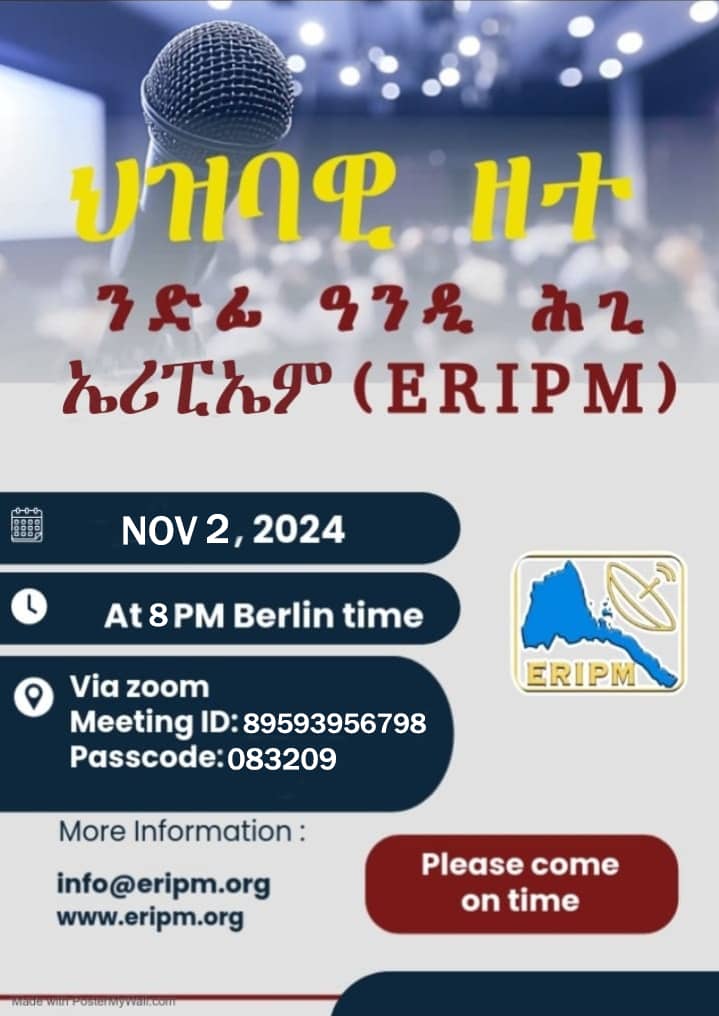
ERITREA PUBLIC MEDIA
DRAFT BYLAW
Table of Contents
ARTICLE 1: NAME AND LOCATION OF THE MEDIA ORGANIZATION.. 2
ARTICLE 2: VISION, PURPOSE, AND VALUE.. 2
ARTICLE 3: ORGONIZATIONAL STRUCTURE.. 3
ARTICLE 5: APPOINTMENT OF OFFICES AND REMOVALS. 5
ARTICLE 6: ROLE AND RESPONSIBILITIES ERIPM OFFICES. 6
ARTICLE 7: OFFICERS MANAGEMENT AND DUTY PROTOCOLS. 9
ARTICLE 8: ADMINISTRATION OF DONATIONS. 11
ARTICLE 9: PROHIBITED ACTIVITIES. 11
ARTICLE 10: OTHER FINANCIAL MATTERS. 12
ARTICLE 11: AMENDMENTS TO BYLAWS. 14
ARTICLE 1: NAME AND LOCATION OF THE MEDIA ORGANIZATION
SECTION 1: NAME OF THE ORGANIZATION
- The name of this organization shall be Eritrean Public Media (ERIPM), that reflects its vision and objectives” henceforth referred by acronym ‘ERIPM’.
- ERIPM, which is a nonprofit, educational and secular corporation is organized under the Nonstock Corporation Act of the State of Maryland (hereinafter “Corporation”).
- ERIPM is public media.
SECTION 2: LOGO
Our logo, like our name, is our identity. It conveys the full collective power of our mission to the public, our members, and supporters.
SECTION 3: OFFICE OF THE CORPORATION
The principal office of this Corporation shall be situated in the State of Maryland at such specific location as the Board of Directors shall determine from time to time. The Corporation may also have such other offices as the Board of Directors determines from time to time.
ARTICLE 2: VISION, PURPOSE, AND VALUE
SECTION 1. VISION
Our vision is to see a prosperous Eritrea that is governed by democratic system that enshrines equality and empowerment of its citizens provided on the constitution to be formulated and agreed upon by the Eritrean People.
SECTION 2. MISSION
Our mission is to establish media television and radio outlet that inform, educate, engage, and empower the Eritrean public and trigger public interest and discussion for open mind-set change, that enables the public to actively participate in the collective efforts to end the dictatorship in Eritrea.
SECTION 4: VALUE
Our values are openness, reflecting truth, standing for justice and freedom, , disseminating accurate information, accountable and ensuring diversity of opinion and ideas.
SECTION 4. PURPOSE
- General Purpose. The Corporation is organized and operated for the following general purposes:
- Exclusively for charitable and educational within the meaning of §501(c)(3) of the Internal Revenue Code of 1986 (as amended) or the corresponding provision of any future United States internal revenue law, including for such purposes, the making of distributions to organizations which are recognized as exempt from tax under such §501(c)(3).
- To exercise such of the rights, powers, duties and authority of a nonprofit corporation organized under the Maryland Nonstock Corporation Act of the State, which are consistent with the preceding paragraph.
- To raise awareness through civic education around human rights and good governance
- To encourage dialogue among Eritrean, media and others interest group in advancing human rights, conflict resolution and promotion of tolerance, equality and diversity.
- Specific task
- To capture/document and share/disseminate information to Eritrean public.
- To conduct and facilitate interviews, dialogues, and panel discussion on the issue of human rights that accelerates the need for democratic change in Eritrea.
- To mobilize Eritreans in the diaspora to stand for justice and democracy in Eritrea.
- To identify and recruit talent Eritrean professionals to work with the media team.
ARTICLE 3: ORGONIZATIONAL STRUCTURE
Figure 1: Organizational structure of ERIPM
SECTION 1. ORGANIZATIONAL HIERARCHY
The ERIPM has seven important Organs:
- General Assembly
- Board of Directors
- Chief Executive Officer
- Departments and Support Staff
- Advisory Board
- Election and Grievance Committee
- Audit
SECTION 2. GENERAL ASSEMBLY
Supremacy of the General Assembly
The General Assembly is the supreme body of the ERIPM.
SECTION 3. POWERS AND RESPONSIBILITIES OF THE GENERAL ASSEMBLY:
- To amend & ratify the ERIPM Bylaws when it is necessary.
- To elect members of the Board of Directors
ARTICLE 4: MEMBERSHIP
SECTION 1: GENERAL ASSEMBLY MEMBERSHIP
- ERIPM is a non-profit corporation, and its global membership is open to any Eritrean 18 years age and older.
- Any voluntary servants of the ERIPM by default becomes a member of general assembly with no obligation of membership fee.
Conditions of members
- Who has a legitimate interest in the objective, core values, mission and vision of the ERIPM
- Who agrees to bide by the provisions contained in the ERIPM Bylaws
SECTION 2: GENERAL ASSEMBLY RIGHT & RESPONSIBILITIES
SECTION 2.1: MEMBERSHIP RIGHT
- Each member has a single absolute right to vote in electing Board of Directors or any other body as required
- Elect and to be elected as a member of the Board of Directors or any other position/office as required
- Ratify and amend the Bylaws, when it is required
SECTION 2.2: RESPONSIBILITIES OF MEMBERS
Shall be the duty and responsibility of each member of the ERIPM to:
- Work in the interest of the ERIPM and to advance the projects and policies of the ERIPM.
- Align and abide by the Bylaws ad defend ERIPM from harmful elements
- Participate in meetings, demonstrations, campaigns as directed by the Board of Directors
- Pay monthly membership dues (will be defined, drafted and agreed by Board of Directors) – a member who carries unpaid subscription does NOT have the right to vote in any election organized by the Election and Grievance Committee or any other decision taken by the General Assembly.
SECTION 5: TERMINATION OF MEMBERSHIP
A member can be terminated by the General assembly if they repeatedly violated the Bylaws, however, before termination, a member shall be given two written notices of warning by the Board of Directors after getting approval from the General assembly
SECTION 6: HONORARY MEMBERSHIP
The Board of Directors can give honorary membership to individuals who contributed for the organization with out being registered members, such membership neither bear any voting power nor hold any elected positions.
SECTION 7. LEAVE OF ABSENCE
- Upon a temporary leave of absence by one of the Executive Board Members, the Executive Board should nominate a replacement for approval by the Board of Directors
- Should a member of the Board of Directors leave their Office, the Board of
Directors need to replace them until the next General Assembly meeting is due.
ARTICLE 5: APPOINTMENT OF OFFICES AND REMOVALS
SECTION 1: BOARD OF DIRECTORS
The General Assembly members elect a 5–9-member Board of Directors with extra 3 reserves for any eventualities on the waiting list
SECTION 2: CHIEF EXECUTIVE OFFICE APPOINTMENT
- The Board of Directors appoint the Chief Executive Officer and approved by the General Assembly
SECTION 3: DEPARTMENT HEADS APPOINTMENT
- The Department Heads are hired/appointed competitively by the CEO and approved by the Board of Directors and are accountable to the CEO. However, the CEO needs to get approval from the Board of Directors before hiring or appointing the Department Heads.
SECTION 4: REMOVAL OF THE CHIEF EXECUTIVE OFFICER
- A Chief Executive Officer can be removed by the Board of Directors up on the approval of the General assembly, based on the disciplinary guidelines agreed by both parties (The Board and the Chief Executive Officer)
- A Department Head can be removed by the CEO in consultation with the Board of Directors based on the disciplinary guidelines agreed by both parties
SECTION 5: ELECTION AND GRIEVANCE COMMITTEE
- A 5-7 membered Election and Grievance Committee is elected by the General Assembly to facilitate the election process of the Board of Directors
- Develop tools for selection criteria as election procedure
- Prepare a list of potential nominees for the Board of Director positions as per the set criteria to be elected by the General Assembly
- Serve as mediators upon any conflict within the organization; when a deadlock arises, the case should be transferred to the General Assembly
SECTION 6: ADVISORY BOARD
A 5-7 membered Advisory Board is elected by the Board of Directors to advise the Board of Directors and the Executive Branch. Role and responsibilities of the Advisory Board:
- To provide technical and strategic support in the decision-making process
- To advice on legal, content production, distribution strategies, and audience engagement tactics
- To facilitate networking opportunities and partnerships
ARTICLE 6: ROLE AND RESPONSIBILITIES ERIPM OFFICES
SECTION 1: ROLES AND RESPONSIBILITIES OF THE BOARD OF DIRECTORS:
- To develop a semi-annual plan that aligns to the organization’s strategic objectives. The Board is to monitor adherence to this plan through monthly reports from the Executive Management Team and conducts quarterly Project Management Reviews (PMRs). These reviews assess the progress and performance of ERIPM activities, identifying issues, opportunities, and making recommendations.
- To review and approve annual-annual budget requests, spending plans, and actual expenditures by the Executive Branch and, ensure that adequate internal financial control and audit are in place. The Board shall ensure that the organization has sufficient resources to meet its objectives.
- To appoint and remove the Chief Executive Officer (CEO) as per the service agreement agreed between the Board of Directors and the CEO.
- To conduct, manage and control the affairs of the Corporation, and to make such rules and regulations there of, not inconsistent with law, or with the Articles of Incorporation, or the Bylaws, as they may deem best.
- To designate any place for the holding of any Board of Directors meeting, to change the principal office of the Corporation for the transaction of its business from one location to another; to adopt, make and use a corporate seal and to alter the form of such seal from time to time, as, in their judgment, they may deem best, provided such seal shall at all times comply with the provisions of law.
- To borrow money as required to pay current liabilities.
- To manage in such manner as they may deem best, all funds and property, real and personal, received and acquired by the Corporation.
- To maintain accurate records of the organization’s human and material resources.
SECTION 2: ROLES AND RESPONSIBILITIES OF THE SECRETARY:
- The Secretary shall cause to be kept at the principal office of the Corporation, the Secretary’s principal place of business, or such other place as the Board of Directors may order, the official seal of the Corporation (if any), and a book of minutes of all meetings of Directors and members.
- The Secretary shall keep a membership book containing names and addresses of each member, and the date upon which the membership ceased.
- The Secretary shall give the notices of the special meetings of the voting members as provided in these Bylaws.
- The Secretary shall also maintain and protect a file of all official and legal documents of the Corporation.
- The Secretary shall perform such other and further duties as may be required by law or as may be prescribed or required from time to time by the Board of Directors or the Bylaws.
SECTION 3: ROLES AND RESPONSIBILITIES OF THE TREASURERS:
- The Treasurers shall have custody of all Corporation funds; keep full and accurate accounts of all receipts and disbursements of the Corporation, an inventory of assets, and a record of the liabilities of the Corporation; deposit all money and other securities in such depositories as may be designated by the Board of Directors; disburse the funds of the Corporation as ordered by the Board of Directors taking proper vouchers for disbursements; and prepare all statements and reports required by law, by the Chairperson or by the Board of Directors.
- Provide guidance to the Finance Department under the Executive Branch.
- Get accounting reports from the Finance Department and consolidate financial statements of the Corporation and prepare accounting supporting documents for audit.
- The Treasurers shall have such other duties and responsibilities and may exercise such other powers as are usually incident to the office or as from time to time may be assigned by these Bylaws, the Board of Directors, or the Chairperson.
SECTION 4: ROLES AND RESPONSIBILITIES OF THE CHIEF EXECUTIVE OFFICER:
- To lead the Executive Branch and make all efforts to achieve the objectives, mission and vision stipulated on the Bylaws.
- To headhunt qualified Department Heads and present them to the Board of Directors for approval before hiring or appointing.
- To headhunt qualified journalists/technicians together with the Department Heads and present them to the Board of Directors for approval before hiring or appointing.
- To prepare the short and long-term operational and strategic plans with the Department Heads and present it to the Board of Directors for approval.
- To make sure that the Department Heads are fulfilling their duties based on the responsibilities detailed in the Bylaws and short and long-term operational and strategic plans.
- To develop internal rules and regulations by engaging all stakeholders that helps Human Resources to fulfil their activities of the Executive Branch effectively and efficiently.
- To report activity reports to the Board of Directors on a quarterly and annual basis.
- The CEO leads the day-to-day management of the organization, ensuring that all operations align with the strategic goals defined by the Board of Directors. This involves translating high-level strategies into actionable plans, overseeing resource allocation, and managing the organization’s personnel to support strategic objectives.
- The CEO also serves as the main conduit between the Board of Directors and the Executive Branch , providing regular updates, insights, and reports on progress and challenges.
- Additionally, the CEO represents the organization externally, fostering relationships with key stakeholders, including donors, partners, and the media, to promote the organization’s mission and achievements.
- The CEO in collaboration with the Executive team is also responsible for compliance, risk management, and building a strong organizational team capable of achieving the strategic goals, ensuring the organization not only meets its current objectives but is also poised for future success.
SECTION 5: ROLES AND RESPONSIBILITIES OF THE EDITORIAL BOARD:
- Serve as a guide for maintaining quality standards and journalistic principles for news, editorials, and other scripted programs, providing feedback on all other programs as necessary.
- Monitor editorial statements issued on behalf of ERIPM to ensure they adhere to journalistic standards, objectivity, and accuracy.
iii. Address public complaints and feedback regarding program quality and determine the best ways to accommodate these concerns.
- Organize frequent editorial meetings and other relevant gatherings to evaluate and maintain quality and standards.
- Protect journalistic freedom of expression and shield journalists from internal and external pressure, lobbying and influence.
- Act as a liaison to bridge information, resource and strategic direction gap that might arise between board, staff members and General assembly; facilitating implementation of recommendations from the advisory board and General assembly
SECTION 6: DEPARTMENTS AND SUPPORT STAFF
- Prepare and assemble all contribution
- Work with project management team to review day to day operation
- Program time schedule of each focus area
- To coordinate presenters and writers’ work schedule inline with focus area
SECTION 7: HUMAN RESOURCES SUPPORT STAFF
Recruitment and Talent Acquisition
- Ensure that they hire/appoint the right people for the right roles, considering not only the candidate’s skills and experience but also their passion
- Attract diverse and talented workforce, including journalists, producers, editors, and technical staff. HR shall ensure that candidates have the required qualifications and skills to perform the job successfully
Employee Development
- Shall ensure that employees are continually developing their skills and knowledge to stay up to date with current trends and new technologies
- Shall organize training and on job training, workshops, or other forms of training and development programs
Retention
- Shall create a positive work culture that promotes work-life balance, job satisfaction, and employee engagement.
- Shall conduct regular employee surveys to get feedback from employees and identify areas where improvements can be made.
- Shall prepare succession planning ensures that the organization is prepared for any changes in key positions.
SECTION 8: ADVISORY BOARD
- Advisory board offer valuable support to decision-making process
- Advisory board provide advice and suggest on content production, distribution strategies and audience engagement tactics
- Facilitate networking opportunities and partnership;
- Suggest creative way raising funding and sustainability of the organization
SECTION 9: AUDIT
- A 1-3 membered team with the right skills is hired/appointed by the Board of Directors based on merit
- Shall exhaustive scrutiny of all financial transactions connect to media activities. That includes but is not limited to invoices, contracts, purchase orders, and any other financial documents that pertain to media buying and planning
- Advise the Treasurer and Finance Department to comply with the accounting rules of the land
- The fiscal year of the Corporation shall be from each January 1 to each December 31.
ARTICLE 7: OFFICERS MANAGEMENT AND DUTY PROTOCOLS
In any act of removal of the CEO or a member of the Board of Directors, Electoral and Grievance Committee.
- Terms: All directors shall be elected to serve a two-year term; however, the term may be extended until a successor has been elected.
- Removal/Resignation: Any director may resign from office at any time by giving written notice thereof to the chairperson. Any director may be removed by a two third (2/3) vote of the Board of Directors. Cause for removal exists (without limiting other causes for removal) whenever a Director:
- fails to attend three (3) consecutive regular meetings of the Board of Directors, notwithstanding that he or she otherwise qualifies for office;
- is convicted of a felony;
- has committed a material breach of his or her fiduciary duty;
- has committed an act of moral turpitude;
- ceases to be a member in good standing of the Corporation while in office as a director; or
- breached Corporation’s confidentiality agreement. Before any meeting of the Board at which a vote on removal will be made, the Director in question is given electronic or written notification of the Board’s intention to discuss her/his case and is given the opportunity to be heard at a meeting of the Board. A Director may be removed only at a meeting called for the purpose of removing him. The meeting notice shall state that the purpose or one of the purposes of the meeting is removal of the Director
SECTION 2. MEETING MANAGEMENT PROTOCOL
- Place and Number of Meetings. Meetings of the Board of Directors shall be held at any place which has been designated from time to time by resolution of the Board or by written consent of all Directors. In the absence of such designation for virtual or physical location, meetings shall be held at the principal office of the Corporation. The Board shall hold at least six (6) regular meetings each calendar year. Other business may be transacted at all meetings if proper notice thereof is given. Special meetings of the Board of Directors for any purpose(s) may be called at any time by the Chairperson, or, if the Chairperson is absent, or unable or refuses to act, by one-third (2/3) of the Directors then in office.
- Notice of Meetings. A regular meeting of the Directors may be held without prior notice. Notice of the time and place of special meetings of the Board shall be given personally to the Directors or sent by mail or other form of communication, charges prepaid, addressed to the director at their address as shown upon the records of the Corporation at least three (3) days in advance of such meeting. Such notice shall state the general nature of the business to be considered at the special meeting.
- Quorum and Voting. A quorum will consist of at least the majority (or 50% +1) of the total number of Directors. Every act or decision done or made by a majority of the Directors present at a meeting duly held, at which a quorum was present, shall be regarded as the act of the Board of Directors, unless a greater number is required by law or by the Articles of Incorporation or by these Bylaws. Each director present shall be entitled to one (1) vote. Voting by proxy shall not be permitted. A director may participate in any meeting of the Directors by means of conference telephone or similar communications equipment by means of which all persons participating in the meeting can hear each other. Participation in a meeting pursuant to this paragraph constitutes presence in person at the meeting. The transactions of any meetings of the Board of Directors, however called and noticed, or wherever held, shall be as valid as though they had a meeting duly held after regular call and notice, if a quorum be present and if, either before or after the meeting, each of the Directors not present signs a written waiver of notice or a consent to holding such meeting or an approval of the minutes thereof. All such waivers, consents, or approvals shall be filed with the corporate records or made a part of the minutes of the meeting.
- Presumption of Assent. A director who is present at any meeting of the Directors, or a committee thereof of which the director is a member, at which action on a corporate matter is taken, is presumed to have assented to such action unless a dissent is entered in the minutes of the meeting or unless the director files a written dissent to the action with the person acting as the secretary of the meeting before or promptly after the adjournment thereof. A director who is absent from a meeting of the Board, or a committee thereof of which the director is a member, at which any such action is taken is presumed to have concurred in the action unless the director files a dissent with the Secretary of the Corporation within two days after obtaining a notification or knowledge of the action.
- Action By Unanimous Written Consent. Any action required or permitted to be taken by the Board of Directors may be taken without a meeting and with the same force and effect as if taken by a unanimous vote of Directors, if authorized by writing signed individually or collectively by all Directors. Such consent shall be filed with the regular minutes of the Board.
- Notice of Adjournment. Notice of the time and place of holding an adjourned meeting need not be given to absent Directors if the time and place be fixed at the meeting adjourned.
- Board of Advisors. Board of Directors may choose to elect Advisory Board. Such persons in the Advisory Board shall be nominated by the Chairperson and approved by two third (2/3) of the Board of Directors. Members of the Advisory Board are entitled to attend and participate in meetings of the Board of Directors, but they are not allowed to vote.
ARTICLE 8: ADMINISTRATION OF DONATIONS
- Donations. All donations of any nature, unless designated for a specific purpose, shall be used for such purposes as the Board of Directors may direct; and in the absence of any direction by the Board, such may be used for the general purposes of the Corporation. The Board of Directors has the right to refuse any donation made or offered to the Corporation with or without cause in its sole discretion.
- All Donations Subject to these Bylaws. Donors may make donations to or for the use of the Corporation by naming or otherwise identifying the Corporation in the gift transfer instrument. Each donor by donating to or for the use of the Corporation accepts and agrees to all the terms of these Bylaws.
- Segregation of Funds. No donation shall be required to be separately invested or held unless the donor so directs, or it is necessary in order to follow any other direction by the donor as to purpose, investment or administration, or in order to prevent tax disqualification, or is required by law. However, the Board may segregate any fund whenever convenient or useful.
- Improper Donor Directions. If any direction by the donor, however expressed, would, if followed, result in the use of any donation or fund contrary to the charitable purposes of the Corporation and the Board needs to discuss the matter and made a decision.
ARTICLE 9: PROHIBITED ACTIVITIES
SECTION 1: BINDING BY LAW AND DEGREE OF NEUTRALITY
- Actions Jeopardizing Tax Status. This Corporation shall not carry on any activities not permitted to be carried on by an organization exempt from federal income taxes under §501(c)(3) of the Internal Revenue Code of 1986, as amended, or the corresponding provision of any future United States internal revenue law.
- Non-Discrimination. In the conduct of all aspects of its activities, the Corporation shall not discriminate on the grounds of race, color, national origin or gender.
- Prohibited Acts. At any time during which the Corporation is deemed a private foundation, the Corporation shall not engage in any act of self-dealing as defined in Internal Revenue Code §4941(d); the Corporation shall distribute its income for each taxable year at such time and in such manner as not to become subject to the tax on undistributed income imposed by Code §4942; the Corporation shall not own any excess business holdings that would subject it to tax under Code §4943; the Corporation shall not make any investments in such manner as to subject the Corporation to the tax imposed by Code §4944; and the Corporation shall not make any taxable expenditures as defined in Code §4945(d).
SECTION 2: CONFLICTION OF INTEREST
- Conflicts of Interest. A conflict of interest occurs when a person under a duty to promote the interests of the Corporation (a “fiduciary”) is in a position to promote a competing interest instead. Fiduciaries include all Corporation employees, Directors or officers, and members of any Corporation committee. Undisclosed or unresolved conflicts of interest are a breach of the duty to act in the best interests of the Corporation and work to the detriment of the Corporation.
- Typical Conflict Situations. Conflicts of interest are likely to arise whenever: a) a fiduciary has a personal interest in a vendor of goods or services to the Corporation; b) Corporation employees are loaned to other organizations, or the employees of another organization are loaned to this Corporation; c) Corporation fund raisers give financial advice to donors; or d) project funding requests are submitted by a potential or actual grant recipient with which a fiduciary is connected.
- Discharging Conflicts of Interest. All conflicts of interest must be disclosed to the Board of Directors. After disclosure is made, the individual with a conflicting interest must not participate in judging the merits of that interest. That is, such individual must abstain from voting on, or recommending a course of action with respect to, the situation giving rise to the conflict. When these are done, the conflict of interest has been properly discharged.
- Preventing Conflict Situations. The Corporation, through the Board of Directors, shall encourage all fiduciaries to prevent conflicts of interest where possible.
(i) Fiduciaries should refuse to enter into self-dealing relationships with the Corporation as a vendor.
(ii) Fiduciaries should not accept anything but gifts of insubstantial value from vendors.
(iii) The lending of employees to, or acceptance of loaned employees from, other organizations should be avoided. If done, however, a clearly drafted contract defining wages, responsibilities, indemnification and conditions of employment is required.
(iv) Fund raisers should be advised not to recommend that making any donation to the Corporation is in the best interests of a donor.
(v) Financial, tax, and legal aspects of giving to the Corporation should be discussed with a donor only when the donor has independent financial, tax or legal counsel present.
(vi) Donors who plan to make a sizeable gift in response to a personal solicitation should be encouraged to act only with the advice of independent counsel.
(vii) A fiduciary should not participate in any way to submit, review, process or make a recommendation concerning a funding proposal on behalf of any potential or actual grant recipient which employs him or her or with which the fiduciary is affiliated or related, or concerning a funding proposal for a project in which the fiduciary will participate.
ARTICLE 10: OTHER FINANCIAL
MATTERS
SECTION 1: PROPERTY AND ASSET
- Property of the Corporation. The title to all property of the Corporation, both real and personal, shall be vested in the Corporation.
- Dedication of Assets. This Corporation does not contemplate pecuniary gain or profit to the members thereof except as provided by law under §501(c)(3) of the Internal Revenue Code of 1986, as amended from time to time. The property of this Corporation is irrevocably dedicated to tax exempt purposes under said §501(c)(3) as described herein and no part of the net income or assets of this organization shall ever inure to the benefit of any director, officer or member thereof or to the benefit of any private persons.
- Disposition Upon Dissolution. Upon the dissolution or winding up of the Corporation, or in the event it shall cease to engage in carrying out the purposes and goals set forth in these Bylaws, all of the business, properties, assets and income of the Corporation remaining after payment, or provision for payment, of all debts and liabilities of this Corporation, or but not held upon a condition requiring return, transfer or conveyance by reason of the dissolution, shall be distributed to a nonprofit fund, foundation, or corporation which is organized and operated exclusively for tax exempt purposes which are reasonably related to the purposes and goals of this Corporation, as may be determined by the Board of Directors of this Corporation in its sole discretion, and which has established its tax exempt status under §501(c)(3) of the Internal Revenue Code of 1986, as amended. In no event shall any of the business, properties, assets or income of this Corporation, in the event of dissolution thereof, be distributed to the Directors, members or officers, either for the reimbursement of any sums subscribed, donated or contributed by the same, or for any other purposes.
SECTION 2: CONTRACTS
Contracts. The Board of Directors may authorize any officer or agent to enter any contract or execute and deliver any instrument in the name of and on behalf of the Corporation. Such authority may be general or confined to a specific instance. Unless so authorized by the Board of Directors, no officer, agent, or employee shall have any power or authority to bind the Corporation by any contract or engagement, or to pledge its credit, or render it peculiarly liable for any purpose or to any amount. When the execution of any contract or other instrument has been authorized by the Board of Directors without specification of the executing officer, the Chairperson, either alone or with the Secretary, may execute the same in the name of, and on behalf of, the Corporation, and any such officer may affix the corporate seal (if any) of the Corporation thereto.
SECTION 3: FINANCIAL ACCOUNTS AND AUDING PROCEDURES
- Financial Accounts. The Corporation may establish one or more checking accounts, savings accounts or investment accounts with appropriate financial entities or institutions as determined in the discretion of the Board of Directors to hold, manage or disburse any funds for Corporation purposes. All checks, drafts or other orders for the payment of money, and all notes or other evidences of indebtedness issued in the name of the Corporation, shall be signed by such officer(s) or agent(s) of the Corporation, and in such manner, as is determined by the Board of Directors from time to time.
- Appointment and Employment of Advisors. The Board may from time to time appoint, as advisors, persons whose advice, assistance and support may be deemed helpful in determining policies and formulating programs for carrying out the Corporation’s purposes. The Board is authorized to employ such persons, including an executive officer, attorneys, accountants, agents and assistants as in its opinion are needed for the administration of the Corporation and to pay reasonable compensation for services and expenses thereof.
- Auditing of Accounts. The accounts of each fund shall, without revealing the identity of any donor who directed anonymity at the time of the donation, be audited in accordance with generally accepted auditing practices by an independent auditor appointed or hired by the Board at such times as the Board may determine.
SECTION 4: LIABILITIES OF THE OFFICERS
- Limitations on Debt. No debt shall be incurred by the Corporation beyond the accounts payable incurred by it as a result of its ordinary operating expenses, and no evidence of indebtedness shall be issued in the name of the Corporation unless authorized by the Board of Directors. Specifically, without limitation, no loan shall be made to any officer or director of the Corporation. Any director or officer who assents to or participates in the making of any such loan shall be liable, in addition to the borrower, for the full amount of the loan until it is fully repaid.
- Liability of Directors and Officers. No director or officer of the Corporation shall be personally liable to its creditors or for any indebtedness or liability and any and all creditors shall look only to the Corporation’s assets for payment. Further, neither any officer, the Board nor any of its individual members shall be liable for acts, neglects or defaults of an employee, agent or representative selected with reasonable care, nor for anything the same may do or refrain from doing in good faith, including the following of done in good faith: errors in judgment, acts done or committed on advice of counsel, or any mistakes of fact or law.
- Liability of Members. No member of the Corporation shall be personally liable to its creditors or for any indebtedness or liability and any and all creditors shall look only to the Corporation’s assets for payment.
- Property Interests Upon Termination of Membership. Members have no interest in the property, assets or privileges of the Corporation. Cessation of membership shall operate as a release and assignment to the Corporation of all right, title and interest of any member, but shall not affect any indebtedness of the Corporation to such member.
ARTICLE 11: AMENDMENTS TO BYLAWS
SECTION 1: ADOPTION
- Except those items specified in these Bylaws as not being subject to amendment, if any, these Bylaws may be adopted, amended, restated or repealed by the General Assembly, by majority vote and shall be effective only upon such amendment.
SECTION 2: INSPECTION BYLAWS
- The original or copy of these Bylaws, as amended or otherwise altered to date, certified by the Secretary, shall always be kept in the principal office of the Corporation for the transaction of business, and shall be open to inspection by the members, officers and Directors at all reasonable times during office hours. In addition, every member is entitled to retain a copy of the latest version of the Bylaws.





